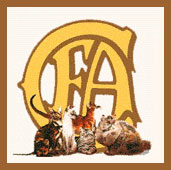 |
|
|||||||
I ran across an article in the June 1989 issue of The Silver Lining, dealing with golden color, which is so good that I want to share the information and hope that you find it interesting. I have also combined some general information on goldens.Golden kittens are born almost black and most have mackerel or classic tabby markings. The kitten's temple area usually indicates the adult color. The brighter the gold color the brighter the adult coat will be. The goldens can go through color changes before reaching adulthood and some goldens do not reach their true color until the age of two or three years. Goldens under two years of age without leg or body bars and that have an evenly tipped coat are rare. Goldens come in different hues of gold. The colors can usually be broken into six color groups. The amount of tipping on the cat determines whether it is chinchilla, shaded, or tabby. Chinchilla and shaded goldens ideally should have no barring but ghost bars are sometimes seen on chinchilla's and shaded's sometimes have bars on the front legs. Barring is a fault in the chinchilla and shaded cats. At this time golden tabbies are not recognized for championship status in CFA. The following color groups address the color of the cat between the root of the hair to where the tipping begins. Honey Platinum – Buffy beige; pale to light ash blond with silvering to platinum hue. The undercoat and color around the armpits and trousers contribute to the overall platinum effect. Tummy, bustle and pantaloons are creamy in color, and the tipping is seal brown to black. Honey Golden – Wheat color; pale blond with a yellow hue. It shows a faint platinum hue in some cats. There is no apricot, orange or red in this coat. Tummy bustle and pantaloons are pale yellow/cream. Tipping may be black, seal or medium brown. Honey Apricot – A true Strawberry color, with a delicate pink tone blending to apricot, wheat with light reddish hue. This coat shows little or no silvering. Tummy, bustle and pantaloons are a pale honey blond. Tipping is a deep apricot rather than black or seal brown. Apricot – An apricot with an orange hue and some yellowing and pinking but no silvering. This is a coveted color by golden breeders. Tipping can be deep apricot, medium brown or seal brown. Black tipping spoils the intensity of the apricot golden. The tummy bustle and pantaloons are a honey apricot color. ….Note: The hocks of the back legs of these four colors are light, varying from platinum to apricot and light brown in the apricot golden. Hocks on the following two colors are darker deep chocolate brown to black. Red Golden – A true "red head", with a ground color of deep apricot to auburn. This is another color coveted by golden breeders. Tipping is usually very dark, seal brown to black. Tummy bustle and pantaloons are a definite apricot. There is no graying in this coat color.Brown Golden – Definite brown hued cat with very dark tipping. In the "Brownie", the color is a deep, warm brown. A hot red at the spine is sometimes there but nowhere else. The overall cat is a definite brown hued cat with very dark tipping. Tabby barring is more pronounced in this color group. We tend to see more blue-gray color faults on the brown golden and the honey platinum than on the honey apricot, apricot and the red golden Persian. While these six color groups are not officially recognized, experienced golden breeders can identify kittens in their litters and coats on the show bench by these color groups. All goldens fall into one or the other, and whichever color you prefer is a matter of choice.
|